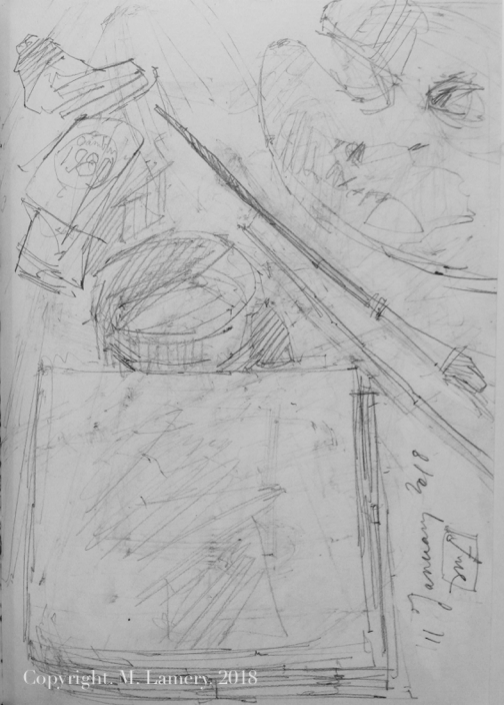I enjoy the rigor of a daily art practice.
Much of my artistic output is created through the practice of making daily paintings. While I can't always paint on a sustained schedule that a long-term daily painting practice requires, I can easily make a drawing.
So, on January 1, 2018, I began to make a drawing a day in my sketchbook. I post the drawings on Instagram.
Typical scene when I am working on small paintings.
For my project, the only constraint I place on the exercise is that I draw directly from life, without the aid of any photographic reference. I draw what is in front of me. If necessary, I finish the drawing at home from memory.
"Now Playing."
One January night on my way home from work, the weather was cold and wet. Because the rain was starting to fall, I had to make a very quick sketch of the movie poster -- adding just enough information to the drawing so that I could finish the work at home. For mood/setting, I also added the figure carrying the umbrella. 17/365
What is interesting about drawing from memory is that when we immerse ourselves in observation, we are paying attention to details about a subject or a setting that otherwise may go unnoticed. I purposefully make mental notes of certain elements of the setting to make sure that I include those details at home.
Observation brings me to another reason I enjoy having a daily practice: the act of observing helps me to be conscious and present of my immediate surroundings. Like painting landscape en plein air, drawing a scene of life is a way to be more present in the moment.
I wrote about my first daily practice its challenges and its rewards when I undertook my first sustained daily practice, "100 Days, 100 Paintings." The rewards of that marathon practice apply to this practice as well: to take chances with making a composition, to be economical with time, to be spontaneous.
Bookstore. The first thing that caught my eye were the books of paintings on the shelf about 20 feet away. Then, a man sat at a table nearby, very engaged in a coffee table book. I decided to put the two images together to form one composition. 13/365
What I particularly enjoy about this daily drawing practice is that the subject does not have to be exotic or complicated. Often, I find myself drawing at the end of the day, sitting on the floor in my home, drawing what I see around me. Making a drawing is a relaxing way to end the day. I actually look forward to this time of the day when all the busy work is done and I can slow down my multitasking mind with making a drawing.
My cat Vincent has his own stack of cat-themed books: "French for Cats," "If Cats Could Talk." The Tale of Tom Kitten." "Meow." On the top of the stack of books rests his hand-made béret that I made. He is pampered. 24/365
I always have my sketchbook with me. I use a small book measuring approximately 5-1/2x8 inches, made by Fabriano. It is flexible and easy to carry around. Each book contains 39 drawings. I have filled one already and am on my second journal. When this project is completed, I will have filled 10 sketchbooks filled with drawings.
These drawings are a record of my daily life. I am thinking I will make a few small paintings from some of these drawings at a later date.
My cat Vincent looking out the window. He is sitting near his toys including a ball of red yarn and a stuffed bunny rabbit. 25/365
I enjoy making these little vignettes of daily life. Already, I am learning so much about quickly capturing a glimpse of the world around me.
To follow the drawings over the course of the year, I invite you to follow me on Instagram to watch the work evolve!
Did you know there is a library containing 36,000 sketchbooks from all over the world? It is maintained at the Brooklyn Art Library. It's called "The Sketchbook Project." It is a global, interactive art library. What an amazing concept and novel library! Think of all the inspiration contained in these creative pages!
Self-portrait. M. Lamery, February 2018.
BIO:
Mary Lamery is a lifelong resident and native of the Pacific Northwest.
Lamery paints regional landscape in a manner that leans towards 19th century French Impressionism. Her landscapes invite the viewer to add to the backstory of the composition through personal identification with the paintings and story telling of the experience.







